The Han River Development: Planning the Riverfront as Seoul’s Natural Landmark
Abstract
1. Introduction
2. Materials and Methods
3. What Can the Case of Han River Development Illustrate in the Waterfront Development Debate?
3.1. A Brief Urban History of the Han River
3.2. The Introduction of Docks vs. the Restoration of the River’s Natural Course
4. Results
The Spatial Characteristics of the Han River Parks and Path Dependency
I remember skating in the Han River in 1963 in an area named jung-ji-do. Before that I used to skate only in places near Biwon Changdeok Palace. One day I went skating in Han River with my relatives and the area was huge! When I was in elementary school, we went to Ttukseom quite often. We would get on a trolley at Dongdaemun, get off at Wangsimni, and get there. I remember that there was wooden shed on stilts near the Korean melon field. I remember it because I had a sudden craving for melons. When we arrived at Ttukseom we swam in the river. There was no shower facility or anything but we did not care for [such things] at the time.
That was it now and then again, there was once again a place for politics. When it comes to the presidential election, the Hangang campaign was the most popular. So, looking at the number of people gathering on the white sandy beach of the Han River, you could guess who will be elected…
Yes, and in the summer, especially in the summer, now there was a lot of flooding. Flood, when it overflowed, it was amazing. Yes, the pigs are just floating away from there. Pigs anyway, chickens, furniture, stuff like that, things like that are just floating away, especially the pigs floating away are so vivid. Yes, we attended Han River Elementary School, and we just went there to take a look.
There were no noteworthy interior spaces in Han River waterfront as far as I remember… Although, I remember once that my teacher urged us to visit a friend in the class whose house was damaged by the flood. To check she is all right… Those houses were very rundown and shabby. Yeah, there were those kind of houses in some parts of the waterfront.
If you go to Dongbu Ichon-dong, it’s there. There are drinks, bread, and other things you can buy and eat. There are bathrooms, and now I eat everything at home, so there’s no need for it. Those who need it can bring some water and drink it there, and if you go to Dongbu Ichon-dong over there, they sell ramen and various things to eat. Because I eat everything at home, and when I exercise, I don’t eat a lot. A few people I exercised, one or three did eat outside. Yes, but I don’t bring food with me. It’s because I eat at home.
5. Discussion
6. Conclusions
Funding
Institutional Review Board Statement
Informed Consent Statement
Data Availability Statement
Acknowledgments
Conflicts of Interest
References
- Seoul Metropolitan City. Hangang Renaesangsu [Han River Renaissance]; Seoul Metropolitan City: Seoul, Korea, 2008. [Google Scholar]
- Korean Research Institute for Human Settlements (KRIHS). A Study for a Comprehensive Plan for the Han River’s Nature Restoration and Development of Tourism Resources; KRIHS: Seoul, Korea, 2015. [Google Scholar]
- Seoul Metropolitan City. A Historical Change Seen from the Sky [Hanul ehso bon Sowool ui Byonchonsa]; Seoul Metropolitan City: Seoul, Korea, 2013. [Google Scholar]
- Seoul Metropolitan City. Seoul Riverfront Vision 2030 [Hangangbyon Gwanri Gibon Gaehoek]; Seoul Metropolitan City: Seoul, Korea, 2015. [Google Scholar]
- Korean Federation for the Environmental Movement (KFEM). Han River’s Miracle [Hangagn ui Gijok]; Imagine: Seoul, Korea, 2010. [Google Scholar]
- Gordon, D.L.A. Managing the Changing Political Environment in Urban Waterfront Redevelopment. Urban Stud. 1997, 34, 61–83. [Google Scholar] [CrossRef]
- Basset, K.; Griffith, R.; Smith, I. Testing Governance: Partnerships, Planning and Conflict in Waterfront Regeneration. Urban Stud. 2002, 39, 1757–1775. [Google Scholar] [CrossRef]
- Baker, A. Metropolitan Growth Along the Nation’s River: Power, Waste, and Environmental Politics in a Northern Virginia County, 1943–1971. J. Urban Hist. 2017, 43, 703–719. [Google Scholar] [CrossRef]
- Bryson, J. Greening Urban Renewal: Expo’74, Urban Environmentalism and Green Space on the Spokane Riverfront, 1965–1974. J. Urban Hist. 2012, 39, 495–512. [Google Scholar] [CrossRef]
- Shaw, K. Docklands Dreamings: Illusions of Sustainability in the Melbourne Docks Redevelopment. Urban Stud. 2013, 50, 2158–2177. [Google Scholar] [CrossRef]
- Wang, C.; Kao, Y.; Huang, J. Riverfront as a Re-territorialising Arena of Urban Governance: Territorialisation and Folding of the Xindian River in Taipei Metropolis. Urban Stud. 2021, 58, 1245–1261. [Google Scholar] [CrossRef]
- Chien, K. Entrepreneurialising Urban Informality: Transforming Governance of Informal Settlements in Taipei. Urban Stud. 2018, 55, 2886–2902. [Google Scholar] [CrossRef]
- Oakley, S.; Johnson, L. Place-taking and place-making in waterfront renewal: Australia. Urban Stud. 2013, 50, 341–355. [Google Scholar] [CrossRef]
- Leung, A. An ‘Othered’ land reclamation project: Decolonization in anticipation of another great flood. J. Archit. Educ. 2021, 75, 170–182. [Google Scholar] [CrossRef]
- Lim, J.Y.; Ono, H. Exploring Inclusive Developments of Water Supply Management in Urban Informal Areas: Case Studies from Mumbai and Nairobi. In Proceedings of the 56th ISOCARP World Planning Congress, Doha, Qatar, 8 November 2020–4 February 2021. [Google Scholar]
- Shah, K. The Sabarmati Riverfront Development Project: Great. But Much Needs to Change. Dly. News Anal. 2013. Available online: https://architexturez.net/doc/az-cf-166149 (accessed on 17 February 2022).
- Vriddhi, V. Riverfront Development in Indian Cities: The Missing Link. GSTF J. Eng. Technol. 2017. [Google Scholar] [CrossRef][Green Version]
- Earth Celebration Website. Available online: https://earthcelebrations.com/vaigai-river-restoration-pageant-project/ (accessed on 21 February 2022).
- Pinto, P.; Kondolf, G. The Fit of Urban Waterfront Interventions: Matters of Size, Money and Function. Sustainability 2020, 12, 4079. [Google Scholar] [CrossRef]
- Chang, T.C.; Huang, S. Reclaiming the City: Waterfront Development in Singapore. Urban Stud. 2011, 48, 2085–2100. [Google Scholar] [CrossRef]
- Djukic, A.; Maric, J.; Antonic, B.; Kovac, V.; Jokovic, J.; Dinkic, N. The Evaluation of Urban Renewal Waterfront Development: The Case of the Sava Riverfront in Belgrade, Serbia. Sustainability 2020, 12, 6620. [Google Scholar] [CrossRef]
- Hoguchongsu [Household and Population Statistics]; Gyujanggak: Seoul, Korea, 1789.
- Jeon, W. Munhwayusan Hangang ui yeoksasong hoebok [Recovering the Han River as cultural heritage]. Gukto 2015, 408, 13–18. [Google Scholar]
- Yi, S. Hwangpo Dotbae: A Symbol of the history of the Hangang River. Wurimunhwa 2020, 285, 26–33. [Google Scholar]
- Lee, M.O. Hangang yogok yiyongui yoksajok gochal [An Historical study of Han riverfront use]. Seoul Munhwa Yongu, 2 May 1999; 9–27. [Google Scholar]
- Kim, T. ‘Hangang hyopreokgaeheok (2015)’ ui uimiwa hyanghoo gwaje [The meaning of the Han River Cooperation Plan (2015) and future projects]. Gukto 2015, 408, 27–34. [Google Scholar]
- Lee, H.E. Hangang ui yuro byonchon gwa jugoh hwangyeong [Changes in the Han River’s flow channel and its residential environment]. Seoul Munhwa Yongu, 2 May 1999; 29–47. [Google Scholar]
- Park, H.; Han, Y. Hangang ui Miraegachi Changchool ul Wihan Seoul Si ui Gwaje [The work that is needed for future value creation in the Han River]. Gukto 2015, 408, 43–48. [Google Scholar]
- Han, S. Hangang un Dongsilmul ui Sohsikji Yigido [Hang River is also a habitat for animals and plants]. Wolgan Hwangyeong 2007, 79, 45. [Google Scholar]
- Hong, S. Seoul hangangŭi jinjŏnghan bokwonŭl Hyanghae [Toward a true recovery of the Han River]. Inmulgwasasang 2010, 145, 50–60. [Google Scholar]
- Kim, J.S. Hangang ui sengsan: Hanguk ui baljonju-ui doshihwa wa ingan nomo ui mul gyonggwan [Producing the Han River: South Korea’s developmental urbanization and more-than-human waterscape]. Gonggan gwa Sahoe 2019, 29, 93–155. [Google Scholar]
- Park, S.; Kang, J.; Jeong, D.; Kim, S.; Baek, S. Hangang Renaesangsu Jeongyok Haebu [Anatomy of the Han River Renaissance]. Wolgan Hwangyeong 2007, 79, 24–47. [Google Scholar]
- Myong, S.Y.; Kim, C. “Hanguk ui Landumaku Hanggang Temsugang Buropji Anta” [“Korea’s landmark Han River project is not in envy of the Thames River”]. Maekyong Econ. 2008, 1486, 26–39. [Google Scholar]
- Ministry of Land, Transport, and Maritime Affairs. The Project Report for the Gyongin Canal. [Gyonin Wunha Saup Gyehoek]; MLTMA: Seoul, South Korea, 2009.
- Yoon, J. Gong-in-doen Sagi-geuk Arabat-gil Myeonching butoh Bakkwŏ ya Incheon in the News. 2019. Available online: https://www.incheonin.com/news/articleView.html?idxno=51285 (accessed on 16 June 2021).
- Rossano, F. The Isan Plan: The Wild as the new urban? Contour 2016, 1, 1–10. [Google Scholar]
- Armomat, T. The Isar River in Munich: Return of the wilderness. Topos Int. Rev. Landsc. Archit. Urban Des. 2011, 77, 38–42. [Google Scholar]
- Kim, K. A Study of Controversy Regarding the Removal of Water Beam in Jamsil and Singok. [Jamsil mit Singok Sujungbo Chulgoh Nonran eh daehan Gochal]. J. Environ. Hi-Technol. 2012, 225, 34–44. [Google Scholar]
- Board of Audit and Inspection, South Korea. Pyonghwa ui Dam Gonseolsaup Choojinshiltae Gamsa Gyeolgwabogo [Inspection Result Report on the Construction Project of the Peace Dam]; Board of Audit and Inspection: Seoul, Korea, 1993. [Google Scholar]
- Yeom, H.C. Nengjon gwa Bulsin ui Ginyeombi ‘Pyonghwa ui Dam’ [The Peace Dam: A Monument to the Cold War and its discrediting]. Hangang gwa Saramdeul 2004, 1, 22–24. [Google Scholar]
- Millington, N. From urban scar to ‘park in the sky’: Terrain vague, urban design, and the remaking of New York City’s High Line Park. Environ. Plan. A 2015, 47, 2324–2338. [Google Scholar] [CrossRef]
- Patrick, D. The matter of displacement: A queer urban ecology of New York City’s High Line. Soc. Cult. Geogr. 2014, 15, 920–941. [Google Scholar] [CrossRef]
- Lynch, K. The Image of the City; MIT Press: Cambridge, MA, USA, 1960. [Google Scholar]
- Song, J.; Park, J. A Study of the improvement of Han-Gang Park by analysis of users’ behavior, focusing on Banpo, Yeouido. J. Urban Des. Institude Korea 2013, 14, 43–54. [Google Scholar]
- Baek, C. Nunchong batnun Dijain Seowul ui Yusandeul… [Seoul’s design heritage receiving glare…]. Jugangyonghyang 2014, 1071, 38. [Google Scholar]
- Kim, J. Sevit Dungdung Seom susul… [Sevit Floating Island under ‘surgery’…]. Newsis 2012, 287, 20–21. [Google Scholar]
- Groth, J.; Corijn, E. Reclaiming urbanity: Interminate spaces, informal actors and urban agenda setting. Urban Stud. 2005, 42, 503–526. [Google Scholar] [CrossRef]
- Sheridan, D. The Space of subculture in the city: Getting specific about Berlin’s indeterminate territories. Field A Free. J. Archit. 2007, 1, 97–119. [Google Scholar]
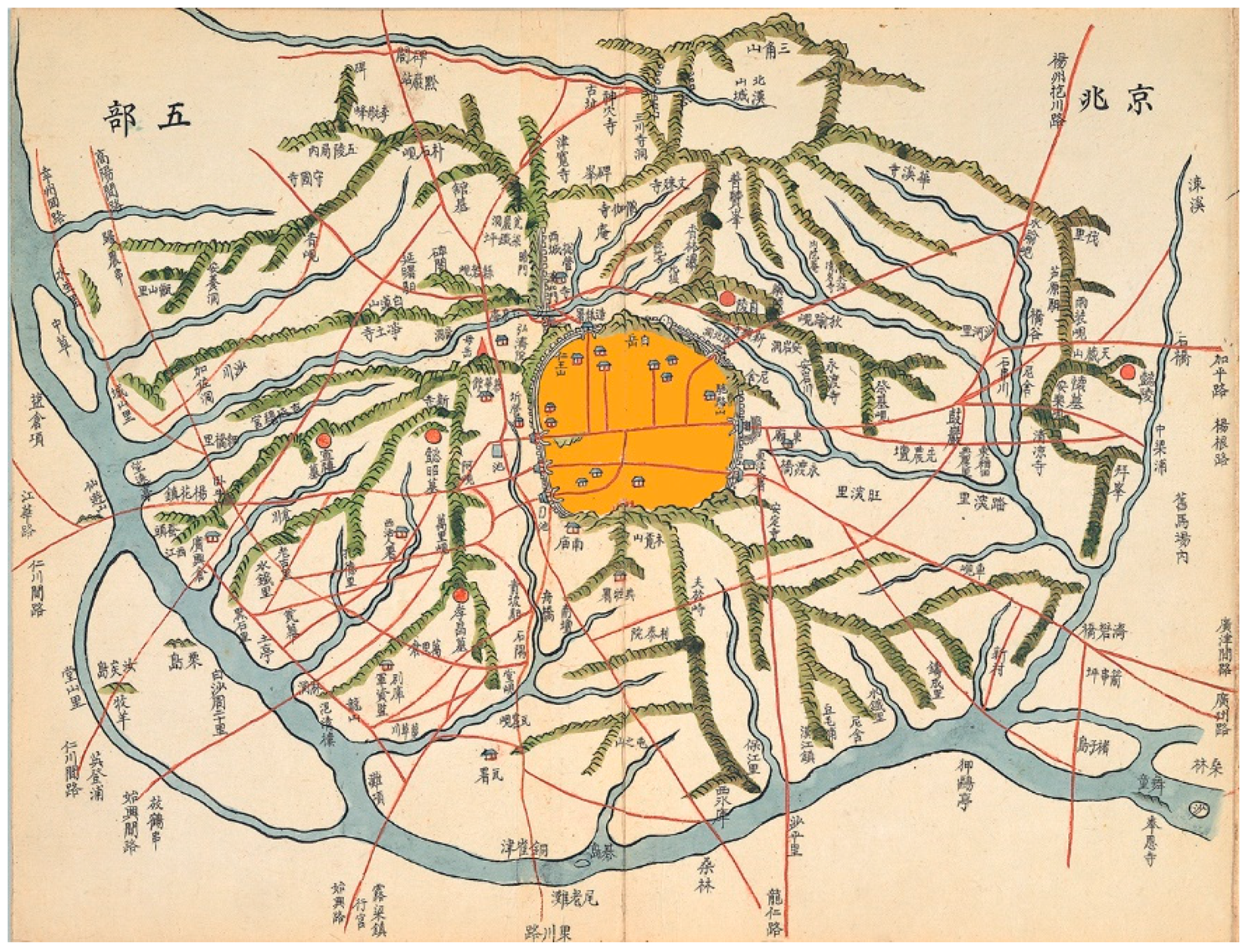
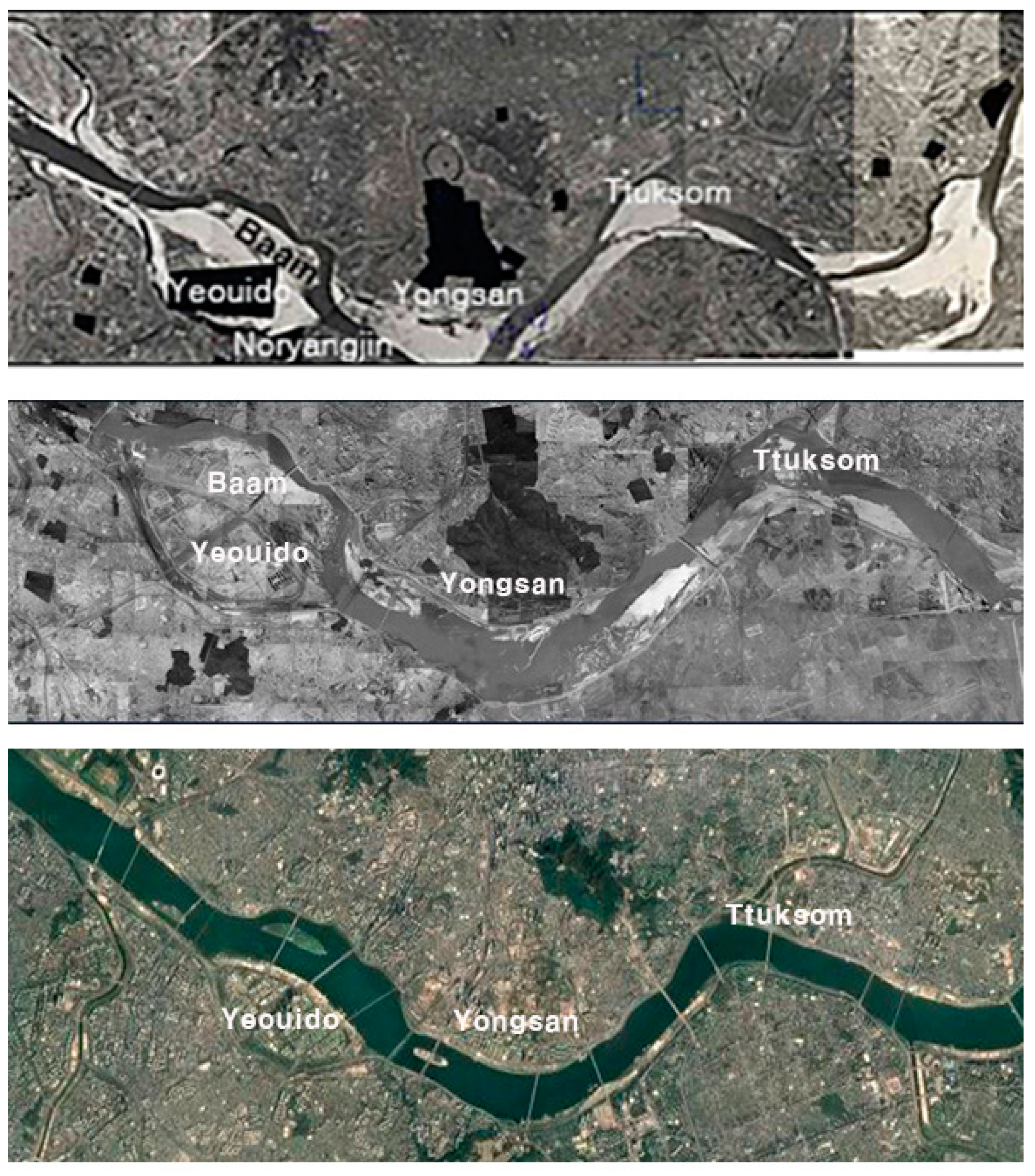
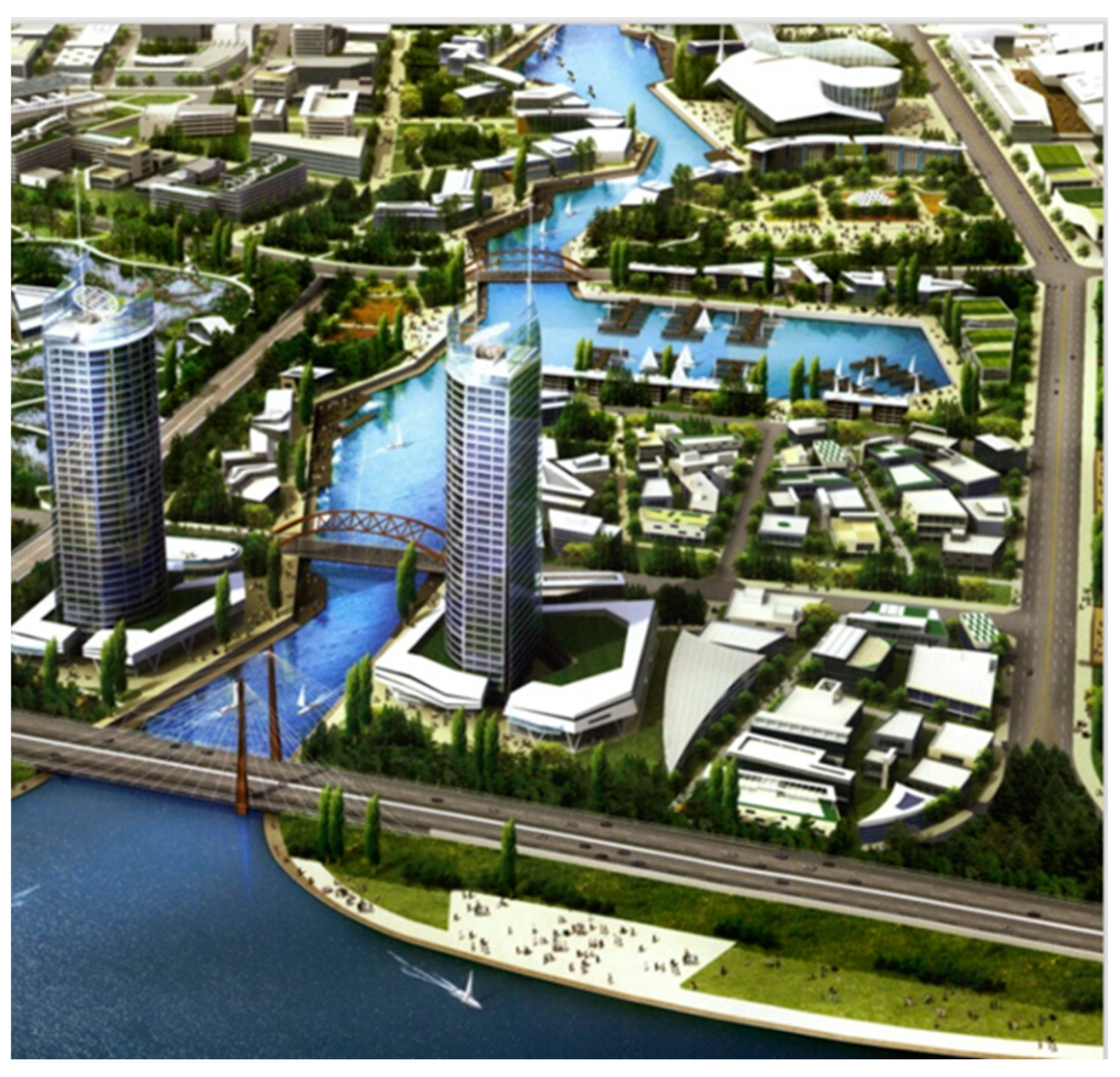
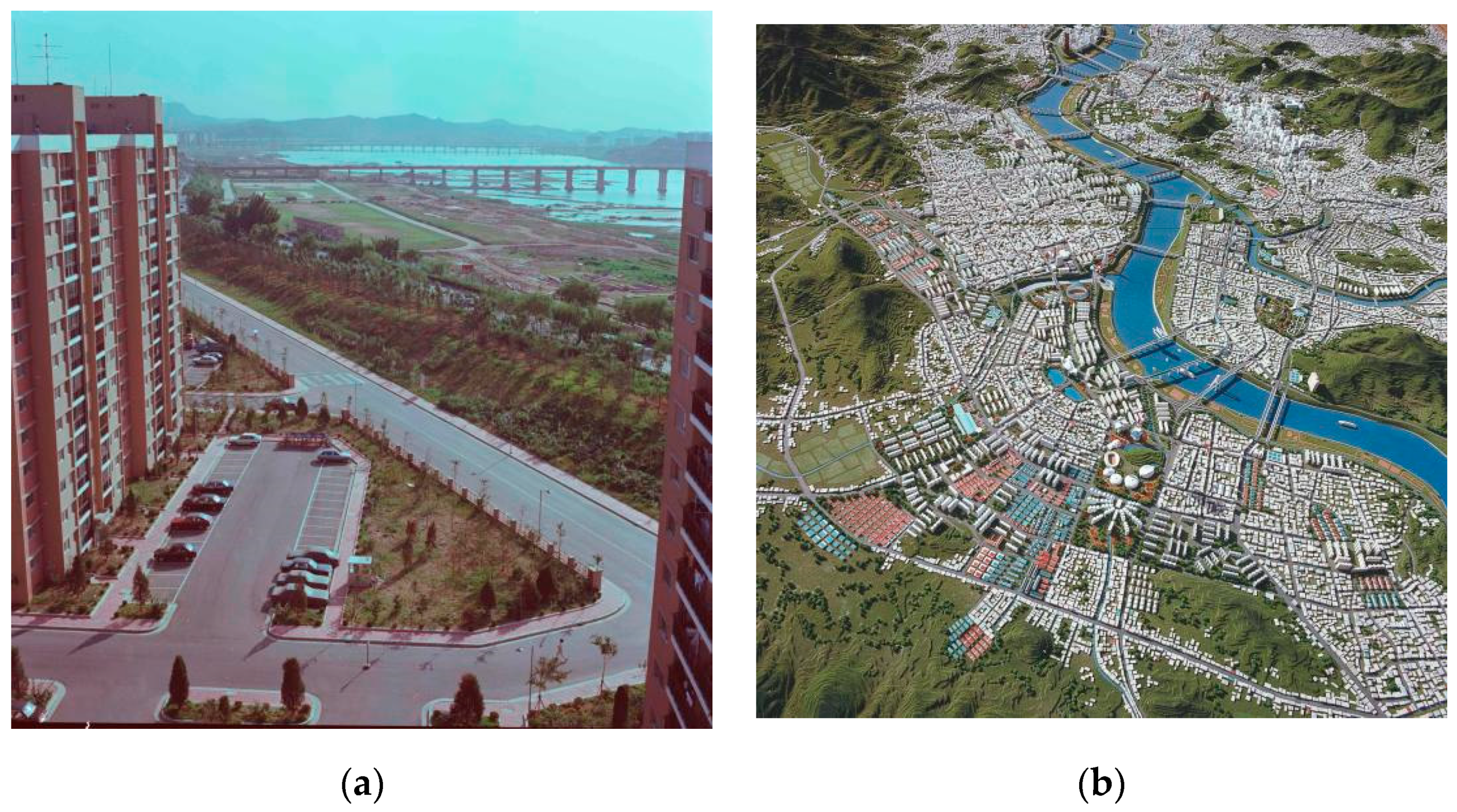
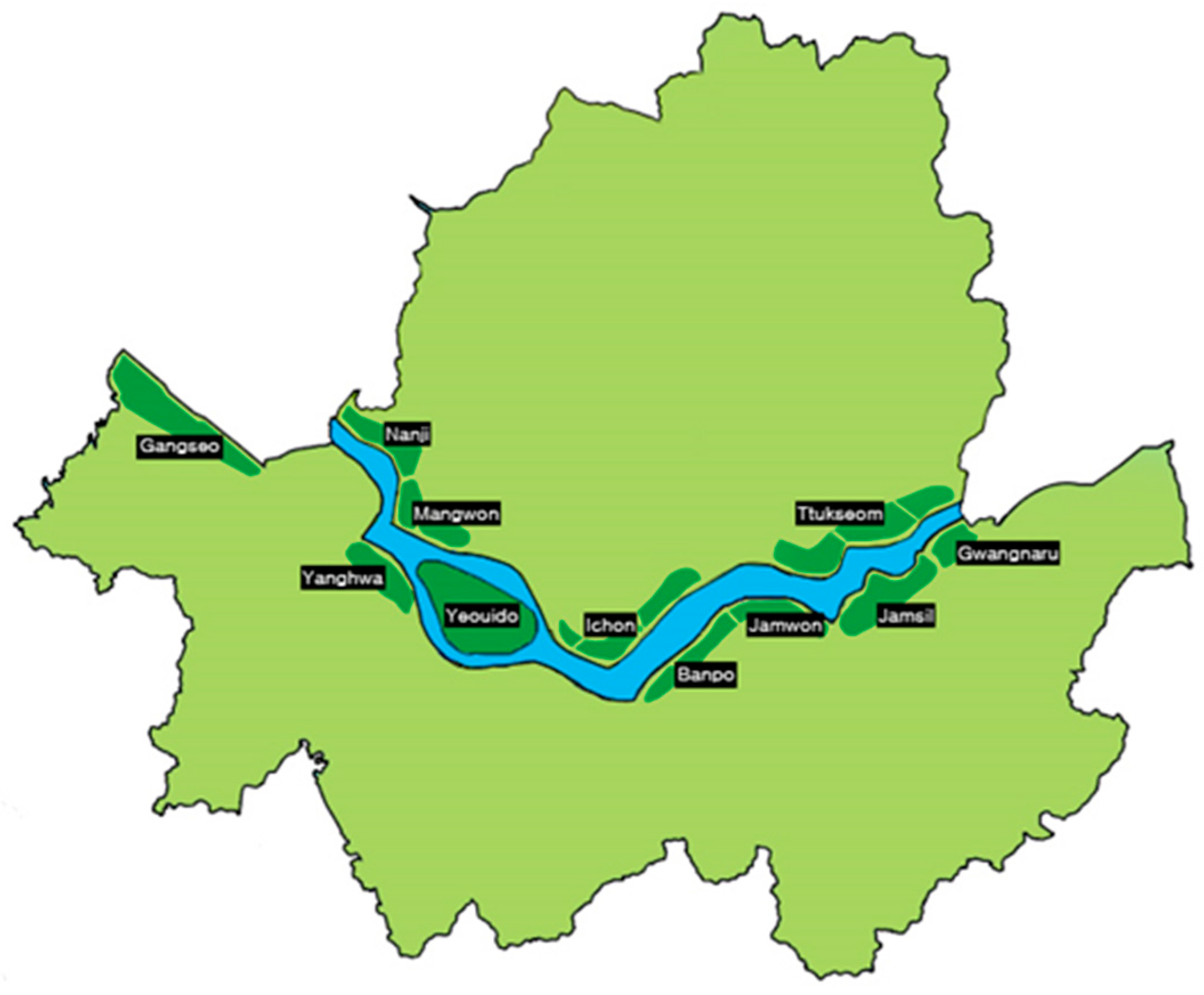
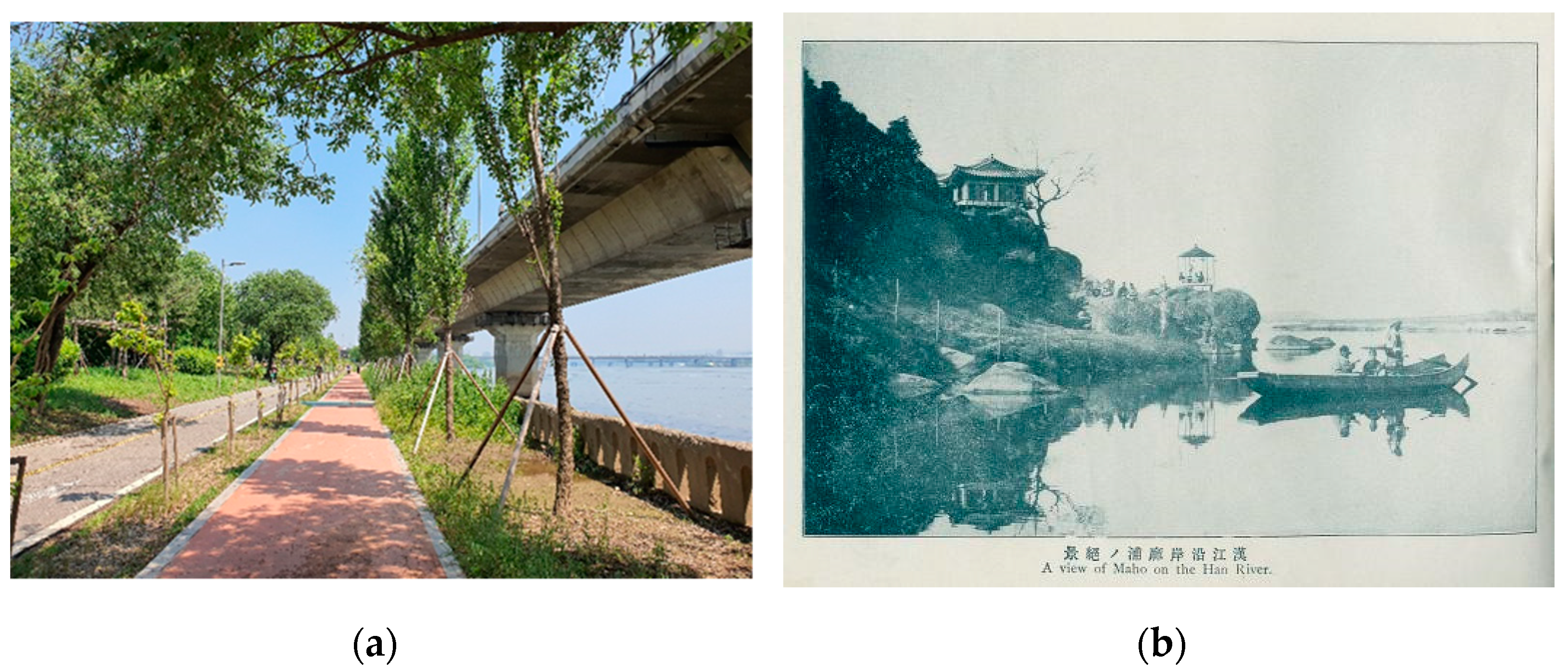
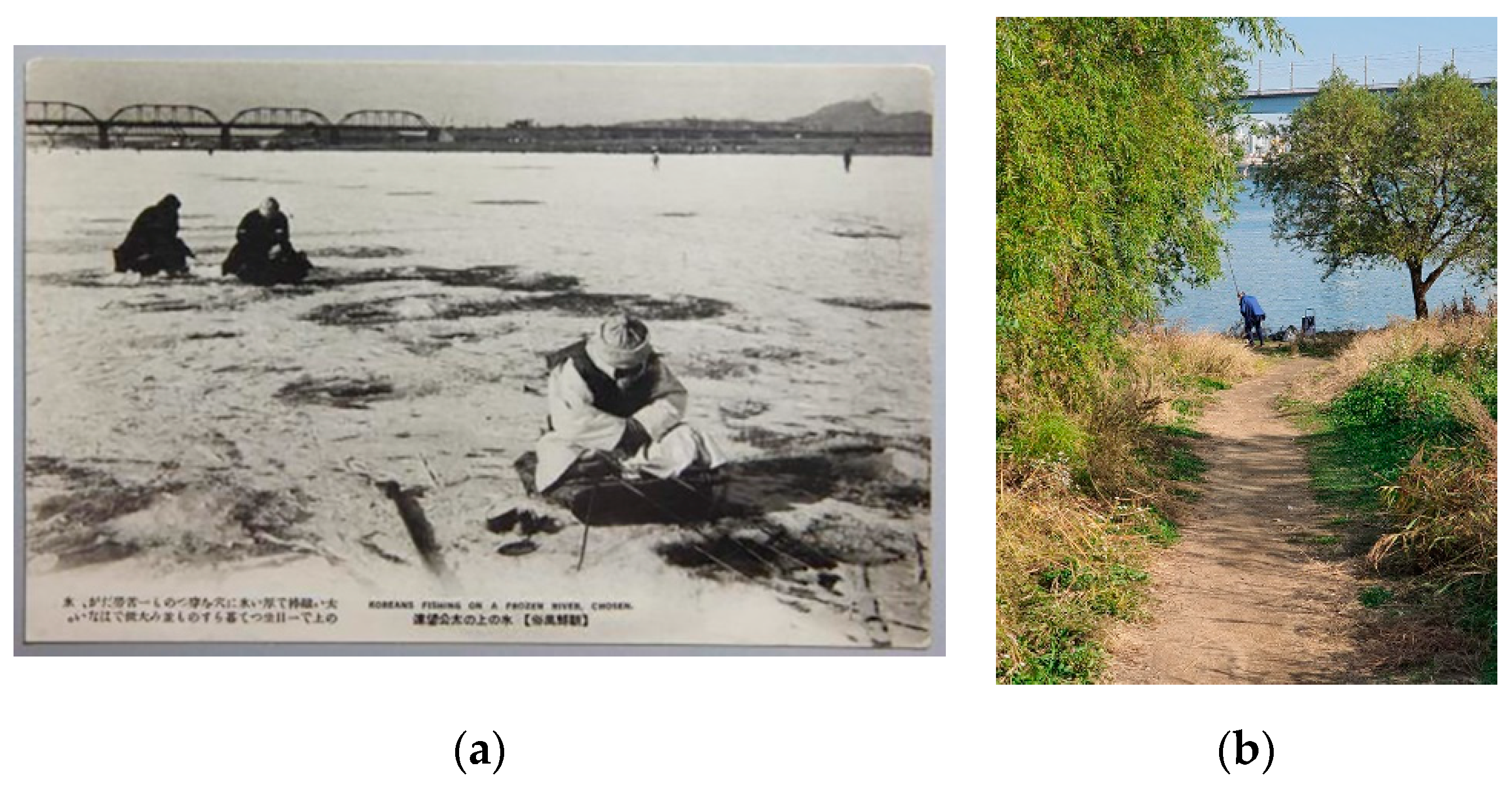

| Agree | Do Not Agree | Not Sure | |
|---|---|---|---|
| Sandy riverside and ecological course of the river should be restored in certain area. | 10 | 8 | 8 |
| More indoor cultural and commercial facilities should be constructed in certain area. | 8 | 12 | 6 |
Publisher’s Note: MDPI stays neutral with regard to jurisdictional claims in published maps and institutional affiliations. |
© 2022 by the author. Licensee MDPI, Basel, Switzerland. This article is an open access article distributed under the terms and conditions of the Creative Commons Attribution (CC BY) license (https://creativecommons.org/licenses/by/4.0/).
Share and Cite
Yun, J. The Han River Development: Planning the Riverfront as Seoul’s Natural Landmark. Sustainability 2022, 14, 4011. https://doi.org/10.3390/su14074011
Yun J. The Han River Development: Planning the Riverfront as Seoul’s Natural Landmark. Sustainability. 2022; 14(7):4011. https://doi.org/10.3390/su14074011
Chicago/Turabian StyleYun, Jieheerah. 2022. "The Han River Development: Planning the Riverfront as Seoul’s Natural Landmark" Sustainability 14, no. 7: 4011. https://doi.org/10.3390/su14074011
APA StyleYun, J. (2022). The Han River Development: Planning the Riverfront as Seoul’s Natural Landmark. Sustainability, 14(7), 4011. https://doi.org/10.3390/su14074011






